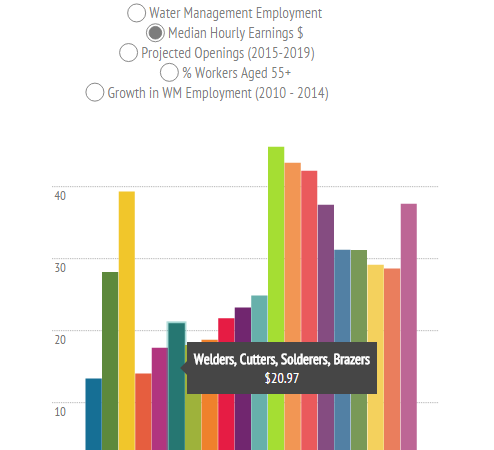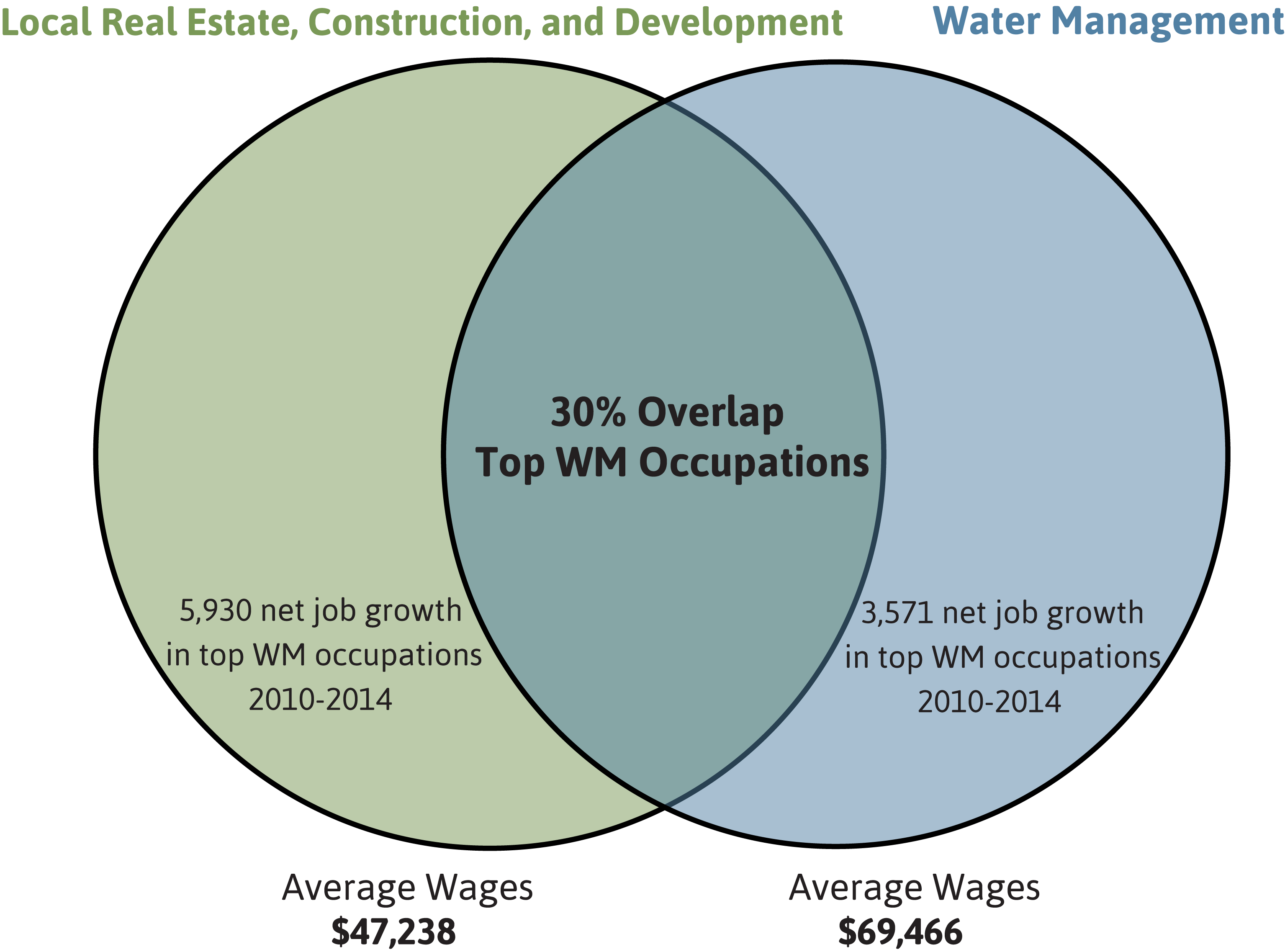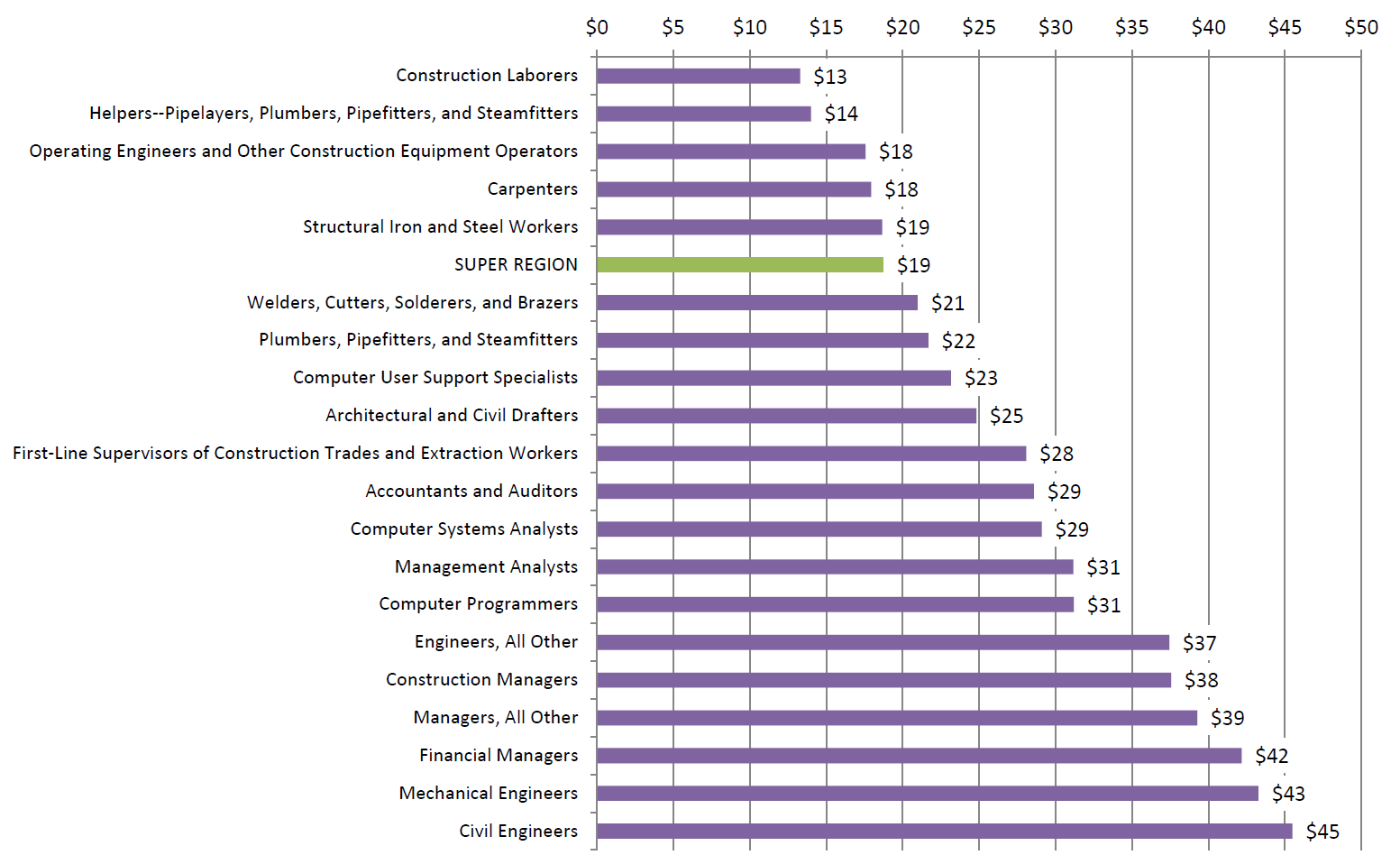
The Water Workers: Workforce Opportunities in Water Management in Southeast Louisiana
Published: Dec 23, 2014
Southeast Louisiana has an unprecedented opportunity to shape a growing water management (WM) economic cluster focused on the costly restoration and protection of our coast. This cluster holds promise for employing thousands of workers in relatively high-paying jobs requiring low-to-moderate levels of education/training. But WM faces competition from the oil and gas and local construction clusters for these workers. If leaders across industries work together to shape and scale up investments in skills training and education, as well as address transportation, this employment boon stands to benefit both workers and employers across Southeast Louisiana.
Background
The deterioration of Louisiana’s coast and the challenge of restoring it has been the focus of significant media attention recently.1 The scale of the restoration challenge is gigantic, with a price tag of $50 billion according to the state’s most recent Coastal Master Plan.2 Even initial steps to execute this plan, while small in comparison to the full effort needed, are nonetheless, enormous.
Large coastal restoration and protection projects already underway are galvanizing forces behind a growing “water management” industrial cluster.3 Employing 64,587 people in 2013, water management is one of the largest clusters in Southeast Louisiana4 and is among the fastest growing.5
There is no doubt that jobs in the water management (WM) cluster will continue to grow. Several tangible factors will fuel this growth for at least the next three to five years, including:
- planned investment from the Coastal Protection and Restoration Authority (CPRA) into sediment diversion, marsh creation, barrier island building, and other large coastal construction projects;6
- local parishes increasingly taxing themselves to fund levees and other protection systems;7
- an invigorated wetland mitigation market responding to the demand from current and planned capital-intensive energy investments;8 and
- private industries along the coast turning to coastal protection measures themselves to combat rising sea levels and demonstrate resiliency.9
This brief highlights the types of jobs that are and will become available in WM, the industry clusters that are competing for the same workers, and areas where there may be opportunity for collaborative training and education investment.
What types of jobs are in the water management industry?
The WM cluster is comprised of relatively high-paying jobs that require low-to-moderate levels of training and education. Of the top 20 jobs in WM, half do not require a college education. Seven occupations do not require an apprenticeship. Nevertheless, the other half of the top WM occupations require either a bachelor’s or an associate’s degree, indicating a level of technical specialization within the WM cluster as well as a need for engineering, information technology, financial, and managerial programs to train these important positions.
Top occupations in water management in Southeast Louisiana, 2014
Source: The Data Center analysis of data from EMSI.
Notes: The top jobs in WM are defined as the occupations with the largest number of jobs within the WM cluster that also represent at least 20 percent of all WM jobs region wide. This 20 percent cutoff was established to filter out administrative positions that exist across all clusters and that are not characteristic of the WM industry specifically.
How much do these jobs pay?
Fully 15 out of the top 20 WM occupations pay more than the regional median earnings for all Southeast Louisiana jobs at $18.73 per hour. And of those water management jobs that pay more than $18.73 per hour, six do not require a bachelor’s degree.
Median hourly earnings for top occupations in water management in Southeast Louisiana, 2014
Source: The Data Center analysis of data from EMSI.
What is the outlook for these occupations?
The excel table that accompanies this brief, Table 1, provides detailed information about the top 20 jobs in WM. The table reveals that:
- More than 3,500 jobs were added in the top 20 WM occupations between 2010 and 2014 in Southeast Louisiana.10 The largest growth was seen in middle-skill occupations, such as welders, carpenters, and pipefitters. There was also significant growth in jobs for accountants and construction laborers.
- In many of the top 20 WM occupations, over 15 percent of the workforce is 55 years old or more.
- New jobs, plus retirements, will yield more than 12,000 job openings11 between 2015 and 2019 in the top 20 WM occupations.
The thousands of projected job openings in the top 20 WM occupations represent an employment boon for Southeast Louisiana. However, because occupations span many industries, WM employers will have to compete with other employers that seek these same skill sets.
What industries compete for these workers?
Of the top 20 occupations in WM, the greatest overlap is with two specific industry clusters: local real estate, construction, and development, as well as oil and gas production and transportation.
Oil and gas has significant overlap with WM. The mutual need for skilled craft workers between WM and the energy and petrochemical manufacturing sector means that of projected new job growth by 2024, a considerable percentage would be in occupations shared by both industries.12 Moreover, the similarity of work shifts and lifestyle in WM and oil and gas makes the clusters direct competitors for skilled and educated labor.13
Water management has a distinct wage disadvantage as compared to oil and gas where average annual wages are $105,817. However, jobs in the WM cluster grew at a faster rate from 2010 to 2014.
Overlap of top water management occupations with oil and gas cluster, Southeast Louisiana, 2014
Source: The Data Center analysis of data from EMSI.
Notes: Average wages refer to all occupations in each industry cluster.
Substantial overlap between water management and local real estate/construction is also notable. Despite lower annual wages, the proximity of local construction jobs to population centers may be more appealing to many workers who would otherwise consider work in coastal restoration.
Overlap of top water management occupations with local real estate/ construction cluster, Southeast Louisiana, 2014

Source: The Data Center analysis of data from EMSI.
Notes: Average wages refer to all occupations in each industry cluster.
The shared occupations between these three industries represents not only possible competition, but also potential for collaboration in skills training and education investment across clusters. With each industry growing jobs, there will be shared challenges to training and scaling up the necessary workforce, as well as transporting workers to job sites away from population centers.
Footnotes can be found in the pdf report that is available for download on the top right of the page.




